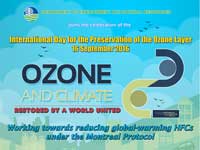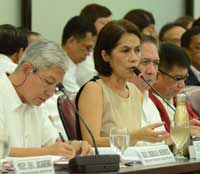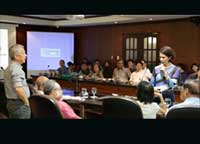DENR LEADS OBSERVANCE OF OZONE PROTECTION MONTH THIS SEPTEMBER

The Department of Environment and Natural Resources (DENR) is leading the nation in observing the Ozone Protection Month this September, which also marks the 31st year since the world agreed for the first time to slash the production and consumption of chlorofluorocarbons (CFCs) and other ozone-depleting substances (ODS).
The agency has lined up several activities to highlight the importance of protecting the ozone layer, a fragile shield of gas that protects the Earth from the harmful portion of the rays of the sun, thus helping preserve life on the planet.
This year marks the 31st anniversary of the Vienna Convention for the Protection of the Ozone Layer, an important milestone in the protection of the ozone layer that happened in 1985. Two years later, representatives from 24 nations met in the Canadian city of Montreal and announced to the world that it was time to stop destroying the ozone layer.
In doing so, these countries themselves, via the Montreal Protocol on Substances that Deplete the Ozone Layer, to rid the world of substances that threaten the ozone layer.
In December 1994, the United Nations General Assembly proclaimed Sept. 16 of every year to be the International Day for the Preservation of the Ozone Layer, commemorating the date when the Montreal Protocol was signed in 1987. The day was first celebrated on Sept. 16, 1995.
The theme for this year’s celebration is “Ozone and Climate: Restored by a World United.” It is in recognition of the collective efforts of the parties to the Vienna Convention and Montreal Protocol for the restoration of the ozone layer and the global commitment to combat climate change.
The Philippines signed the Montreal Protocol on September 14, 1988 and ratified it on March 21, 1991.
As one of the parties to the agreement, the country agreed to the gradual phase out of ODS, particularly CFCs and Hydrochloroflourocarbons (HCFCs).
CFCs and HCFCs are chemical coolants used in refrigerators, air conditioning units, fire extinguishers, thermowares, ice box, water jugs, among others. The country imposed a ban on the importation of CFCs and HCFCs in 2010 and 2013, respectively.
According to a study by the United Nations Environment Program (UNEP), the control, use and phase out of ODS significantly contributed to the protection of the ozone layer.
The UNEP hailed the Montreal Protocol a success, noting that the presence of controlled ODS emissions in the atmosphere is decreasing which signifies recovery of the ozone layer from ODS-induced depletion.
The DENR, through the Philippine Ozone Desk (POD) under the Environmental Management Bureau, is in charge of all activities lined up for the Ozone Protection Month.
The month-long celebration kicked off with a discussion on the eventual phase out of hydroflourocarbons or HFC held in Iloilo City on Sept. 2. It was attended by representatives from civic groups, the youth sector and dealers of ODS. A similar discussion will be held at the Ateneo de Davao University on the last week of September.
For Luzon, the EMB-POD, together with Aksyon Klima Pilipinas, will hold a technology forum on alternatives to ODS and climate protection on Sept. 16 at the Sequoia Hotel in Quezon City.
The forum is intended for industries, importers, end users, and manufacturers of ODS. The discussion will center on the Philippine’s commitment to the Montreal Protocol, HFC phase down, and the imperative linking of ozone layer and climate protection.
On Sept. 6-7, POD staff made surprised visits to shops, service centers and warehouses of ODS importers, dealers, resellers, retailers around Metro Manila to check on their permits and ensure their compliance with DENR standards.
The DENR also scheduled a series of lectures and workshops on ODS use and management, as well as its relation to climate change, from Sept. 9 to 29. ###
- Details
- Parent Category: News & Events
- Category: Press Releases




